This article needs additional citations for verification .(January 2021) |
Many of the museums in Latvia are located in the capital, Riga.
This article needs additional citations for verification .(January 2021) |
Many of the museums in Latvia are located in the capital, Riga.
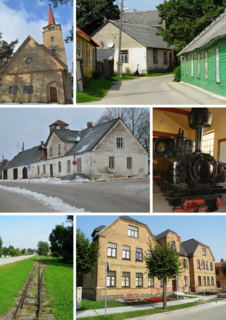
Viesīte is a town in the western part of Jēkabpils Municipality in the Selonia region of Latvia. The population in 2020 was 1,500.

University of Latvia is a state-run university located in Riga, Latvia established in 1919.

Gunnar Birkerts was a Latvian American architect who, for most of his career, was based in the metropolitan area of Detroit, Michigan.
The ArajsKommando, led by SS commander and Nazi collaborator Viktors Arājs, was a unit of Latvian Auxiliary Police subordinated to the German Sicherheitsdienst (SD). It was a notorious killing unit during the Holocaust.
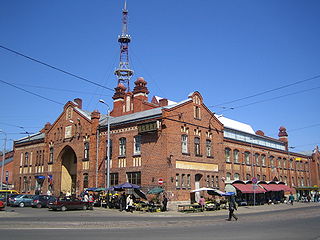
Āgenskalns is a district in Riga, located on the left bank of the Daugava, an old neighbourhood, mainly built in the late 19th to early 20th century. The total area of Āgenskalns is 4,6 km2, which is a lot less than other districts of Riga.

Lucia Peka was a Latvian-American artist. Born in the Governorate of Livonia of the Russian Empire, she became part of the diaspora of artists who fled Latvia during World War II, and eventually settled in the United States where she was a successful painter of landscapes, figures, and still life for almost 50 years. A touring gallery collection travelled within the US Midwest and Washington, D.C.(2010–2011) exhibiting a collection of Peka oil paintings along with other Latvian Displaced Persons of the mid 20th century.
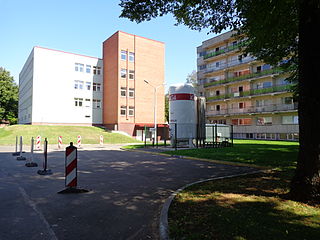
Pauls Stradiņš Clinical University Hospital is an outpatient and hospital health care service provider in Riga, Latvia. This hospital also plays a role in medical science and medical education. It aims to become a science and a training center to residents and prospective doctors and currently is affiliated with two universities. It is named after Pauls Stradiņš.
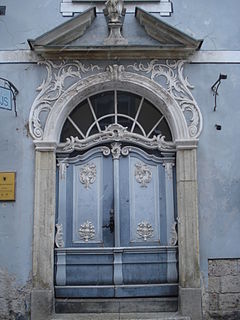
The Latvian Museum of Pharmacy is a medical museum in Riga, Latvia. It was founded in 1987 in association with the Pauls Stradins Museum for History of Medicine and is located on Richard Wagner street in an18th century building which itself is an architectural monument. The museum is dedicated to understanding the development of pharmacy and pharmacies in Latvia and contains documents and books from the 17th- 19th century, pharmacist tools and devices for preparing drugs, and drugs which were manufactured in Latvia in the 1920s and 1930s

Pauls Stradiņš was a Latvian professor, physician, and surgeon who founded the Museum of the History of Medicine in Riga.

Riga Stradiņš University (RSU) is a public university located in the city of Riga, Latvia. The Stradiņš name in the university's title is owed to members of the Stradiņš family who have had a significant influence on the course of community and academic life in Latvia for over a century.
The following is a timeline of the history of the city of Riga, Latvia.
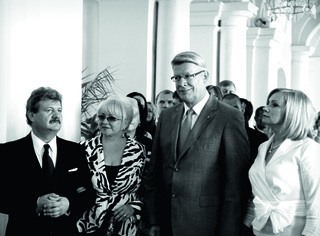
Boriss Teterevs or Boris Teterev was a Latvian philanthropist and private patron in Latvia.

Ināra Tetereva is a Latvian philanthropist and patron of charities in Latvia.

This is a list of government and municipal institutions of Latvia and their subordinated institutions with executive powers:
Pauls Stradiņš Jr. is a physicist at the National Renewable Energy Laboratory in Golden, Colorado, and a foreign member of the Latvian Academy of Sciences.
Paul Stradins Museum of the History of Medicine is museum in Riga, one of the largest medical museums in the world. The exposition presents the development of medicine and pharmacology from ancient times. A separate section is devoted to the history of medicine Latvia.
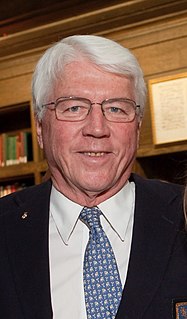
Kristaps Juris Keggi is a Latvian-American orthopedic surgeon. He is considered to be the pioneer of the anterior approach to total hip replacement. He is the recipient of multiple national and international awards and four Honorary Doctorates.

Studia mythologica Slavica is a Slovene academic journal dedicated to ethnology, history, archaeology, linguistics, religious studies, literary history and philosophy in the context of Slavic mythology. Published since 1998 by the Institute of Slovenian Ethnology and the University of Udine. The journal is a annual published in print and online. Articles are published in all Slavic languages, in English, German and Italian. The main goal of the journal is to present comparative research that presents Slavic culture in the broader context of European and non-European cultures. The journal also encourages the study of contemporary phenomena of spiritual, social and material culture and their transformations.